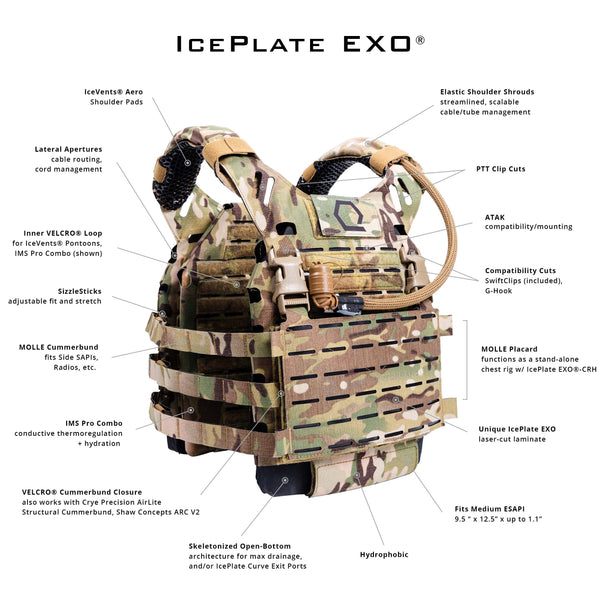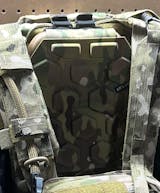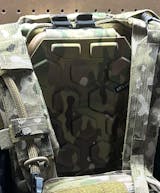Leitfaden zu den Körperschutzstufen

Körperpanzer sind eine wichtige Schutzmaßnahme für alle, die sich in Gefahr begeben: Polizei, Militär, bewaffnete Wachen und alle anderen, für die Schusswaffen eine realistische Möglichkeit darstellen. Allerdings sind nicht alle Körperpanzer gleich. Manche schützen den Träger vor Pistolenkugeln, während andere Körperpanzer vor Gewehrfeuer schützen können. Ein hohes Schutzniveau ist natürlich wünschenswert, bringt aber auch einige erhebliche Nachteile mit sich, darunter Kosten, Größe und Gewicht.
Die Wahl der richtigen Körperpanzerung ist wichtig. Sie möchten nicht zu viel Geld für eine Rüstung ausgeben, die keinen praktischen Zweck erfüllt oder unnötig viel Masse oder Gewicht mit sich herumträgt. Andererseits möchten Sie sich vor glaubhaften Bedrohungen schützen. Körperpanzerungen werden vom National Institute of Justice (NIJ) in verschiedene Bedrohungsstufen unterteilt . Das NIJ legt Teststandards für Körperpanzerungen in den Vereinigten Staaten fest und stuft sie nach Schutzstufe ein.
Die NIJ-Standards (Level IIA, Level IIIA, Level III und Level IV) gibt es schon seit langer Zeit. Ende 2023 veröffentlichte das NIJ neue „Standard Protection Levels“. Dieser Artikel behandelt die alten und neuen Standards, was sich geändert hat und was nicht. Und wir hoffen, dass Ihnen dies bei der Auswahl der Körperschutzausrüstung in Zukunft helfen wird.
Die kurze Antwort: Hier ist eine kurze Aufschlüsselung der NIJ-Schutzstufen …
Die Grundlagen der Körperpanzerung verstehen

Weiche Panzerplatten
Körperpanzerungen werden grundsätzlich in zwei Formen unterteilt: Hartpanzerungen und Weichpanzerungen. Weichpanzerungen bestehen aus weichen, biegsamen Westen. Viele Weichpanzerungswesten sind aus Kevlar gefertigt . Dies sind die kugelsicheren Westen, die Polizisten häufig als Teil ihrer Alltagsuniform tragen. Weichpanzerungen schützen im Allgemeinen nur vor Pistolenkugeln und können einen gewissen Schutz vor Granatsplittern bieten, obwohl die Einstufungen keine spezifischen Splitterschutzgrade angeben. Weichpanzerungen werden manchmal auch in Verbindung mit Hartpanzerungsplatten getragen, insbesondere bei Militärangehörigen, SWAT-Mitarbeitern oder anderen, die einem außergewöhnlich hohen Risiko ausgesetzt sind.
Harte Panzerplatten
Harte Panzerplatten sind viel stärker und können Gewehrkugeln sowie Pistolenkugeln standhalten. Die meisten Platten bestehen aus Keramik. Ballistische Platten halten Gewehrkugeln auf, sind aber starrer, haben mehr Masse und zusätzliches Gewicht. Manche können einzeln getragen werden, andere müssen in Verbindung mit (ICW) weichen Platten getragen werden, um den vollen Schutz zu bieten. Fast alle Militärangehörigen tragen harte Panzerplatten, und das sollte jeder tun, der einer echten Bedrohung durch Gewehrfeuer ausgesetzt ist.
Der Einfluss moderner Körperpanzerung
Die Zahl der durch Körperschutz geretteten Leben lässt sich kaum beziffern. Effektive ballistische Schutzausrüstung hat zahllosen Polizeibeamten das Leben gerettet und die Ergebnisse und Techniken der Gefechtsmedizin völlig verändert. Die Auswirkungen moderner, effektiver Körperschutzausrüstung können gar nicht hoch genug eingeschätzt werden.
Ein detaillierter Leitfaden zu den Schutzniveaus
Die Bestimmung der Schutzstufen von Körperpanzerungen ist Sache des NIJ. Zwei Dokumente beschreiben diese Anforderungen im Detail. Das erste, Ballistic Resistance of Body Armor NIJ Standard-0101.06 , veröffentlicht im Juli 2008, beschreibt die „alten“ Normen im Detail. Dieses Dokument ist immer noch relevant, da es immer noch zahllose Platten und weiche Panzerungsplatten auf dem Markt und im Straßengebrauch gibt, die den alten Normen entsprechen. Das zweite ist Specification for NIJ Ballistic Protection Levels and Associated Test Threats, NIJ Standard 0123.00 , veröffentlicht im Oktober 2023. Die Normen für Körperpanzerungen werden effektiv in Schutz auf Pistolen- und Gewehrniveau unterteilt.

Gliederung der Körperschutzstufen
Schauen wir uns die einzelnen Schutzstufen an. Die alten Stufen sind „NIJ Level xx“ und die neuen „HG1/2“ und „RF1/2/3“. Nach der neuen Namenskonvention steht „HG“ für „Handfeuerwaffe“ und „RF“ für „Gewehr“. Die neuen NIJ-Stufen sind im Wesentlichen nur eine Namensänderung, wobei alle neuen Stufen (außer RF2) direkt einer alten Stufe entsprechen. Glücklicherweise sind alle diese Stufen relativ leicht zu verstehen. Schauen wir uns nun den Schutz an, den jede Stufe bietet.
Die NIJ-Dokumente (die Sie unter den oben stehenden Links selbst lesen können) beschreiben die Testkriterien sehr detailliert. Diese Informationen umfassen die Zusammensetzung und Prüfung des Geschosses (Geschossgewicht, Länge, Pulverladung nach Gewicht usw.), den Einfallswinkel und zulässige Treffer für Testzwecke usw.
So wählen Sie die richtige Schutzstufe
Die Wahl des geeigneten Schutzniveaus ist wichtig. Obwohl wir alle gerne jederzeit Schutz der Stufe IV (RF3) hätten, ist dies weder wirklich notwendig noch machbar. Der zusätzliche Schutz durch eine Rüstung der Stufe IV/RF3 ist sicherlich gut, hat aber Nachteile in Bezug auf Größe und Gewicht. Dies erhöht die Belastung, die Streifenpolizisten Tag für Tag tragen, und Gewehrfeuer ist für die meisten Polizisten eine relativ seltene Bedrohung. Wenn jedoch eine Rüstung der Stufe III/RF1 (und höher) erforderlich ist, gibt es keinen Ersatz! Berücksichtigen Sie bei der Bewertung Ihres Rüstungsbedarfs Bedrohungen, die in Ihrer Einsatzumgebung tatsächlich glaubwürdig sind, und wählen Sie Ihre Rüstung entsprechend aus.
Erweiterte Funktionen der Körperschutzausrüstung, die Sie berücksichtigen sollten
Aufbau eines Körperschutzsystems
Bei der Auswahl von Körperschutz ist es wichtig zu beachten, dass Sie ein System aufbauen und nicht nur mehrere Einzelkomponenten auswählen. Körperschutz wird zusammen getragen. Weiche Schutzkleidung muss in einer Weste untergebracht werden, die am Körper getragen werden kann, und Platten müssen in einem Plattenträger untergebracht werden. Manche Platten sind dafür gedacht, einzeln getragen zu werden, andere sind dafür gedacht, zusammen mit weicher Schutzkleidung getragen zu werden.
Plattenmaterialien
Platten werden aus einer Vielzahl von Materialien hergestellt. Keramik ist aufgrund ihrer Kombination aus relativ geringem Gewicht, ausgezeichnetem Schutz und langer Lebensdauer wahrscheinlich das gebräuchlichste Material. Keramik ist anfällig für Risse, wenn sie herunterfällt, gehen Sie also vorsichtig damit um. Modernere Materialien wie Polyethylen mit ultrahohem Molekulargewicht (UHMWPE) , das in der von uns angebotenen DFNDR-Rüstung verwendet wird, sind extrem leicht, ohne Kompromisse beim Schutz einzugehen.
Tragen Sie Ihre Rüstung richtig
Rüstungen müssen auch richtig getragen werden, um angemessenen Schutz zu bieten. Weiche Körperpanzerungen sollten sich dem Körper so gut wie möglich anpassen. Seitenteile sollten die Seiten des Körpers umschließen. Der Halsausschnitt sollte vorne und hinten hoch sitzen. Dasselbe gilt für Platten; der obere Rand einer vorderen Platte sollte genau auf oder unter der suprasternalen Kerbe liegen . Die hintere Platte sollte ähnlich platziert werden. Dadurch werden lebenswichtige Organe geschützt, einschließlich Herz, Leber, Milz und die großen Gefäße (Aorta und Vena cavae). Es ist auch äußerst wichtig, Körperpanzerungen der richtigen Größe zu haben. Ist sie zu groß, hängt sie durch; ist sie zu klein, schützt sie die Organe nicht ausreichend.
Die richtige Schutzweste auswählen mit Qore Performance
Mit dem richtigen Träger ist es einfach, die richtige Fahrhöhe zu erreichen. Der Qore Performance ICEPLATE EXO ® wird durchweg als der beste ultraleichte Plattenträger bewertet, der in puncto Haltbarkeit oder Tragfähigkeit keine Abstriche macht. ICEPLATE EXO ® hält Ihre Platten bei allem an der richtigen Stelle, vom Fast-Roping über Bootsfahrten bis hin zum Laufen und Klettern an Wänden.

ICEPLATE EXO ® ist an sich schon ein erstaunlicher Plattenträger, lässt sich aber auch nahtlos mit ICEPLATE® Curve integrieren , unserer revolutionären plattenförmigen Wasserblase. Sie bietet nicht nur einfachen Zugang zur Flüssigkeitszufuhr, sondern nutzt auch die thermische Masse des Wassers, um den Träger zu wärmen oder abzukühlen. Bei Qore Performance haben wir uns der Verbesserung der Leistung des menschlichen Bedieners verschrieben und bieten mit unseren Produkten erstklassigen Schutz. Also, worauf warten Sie noch? Kaufen Sie jetzt den ICEPLATE EXO® von Qore Performance. Weitere großartige Optionen finden Sie in unserem Blog über die besten Plattenträger des Jahres 2024 !








Hinterlassen Sie einen Kommentar